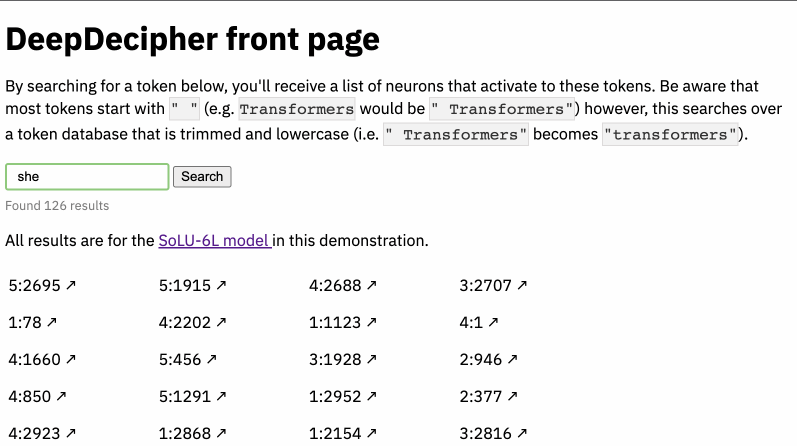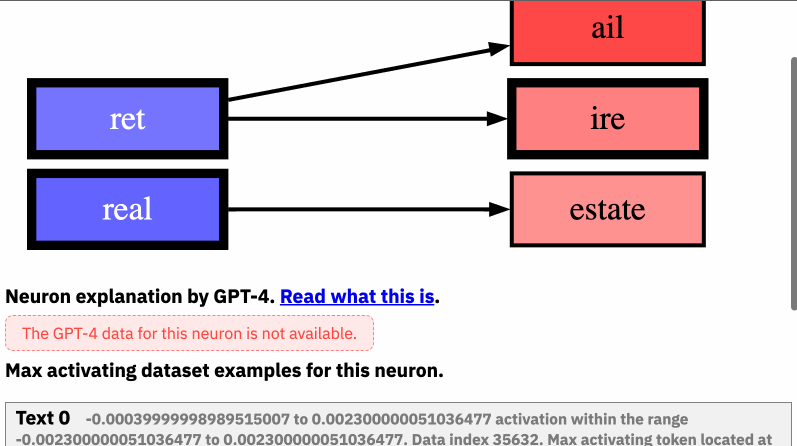🦠 Official repository and open-source website for DeepDecipher.
Paper: Accessing and Investigating Neuron Activation in Large Language Models
Website available here. Contributers, see below for a setup guide. See the data available through the official API.
DeepDecipher is a package that exposes methods to generate information from arbitrary HookedTransformer classes, scrape existing databases of information about neurons within the field of mechanistic interpretability, search over neuron stores generated from the Neuron2Graph package, and set up a server with an API and a server with a UI that interfaces with the API.
As part of the publication of the paper, we also present a publicly available API developed using DeepDecipher (TBD).
See the search UI in action here:

See the neuron information UI pages in action here:

- The DeepDecipher Python package to dynamically load neuron information from any available existing APIs, such as neuroscope.io and the OpenAI Neuron Explainer API.
- The DeepDecipher Python package also provides functionality to compile data folders from any setup script and serve it as a data-efficient API on a server. This includes a simple setup to use raw JSON.
- The DeepDecipher API is an extensible and active API to relevant variables for single-neuron analysis
- The API has access to relevant layer- and model-size information, such as layer neurons sorted by how interesting they are
- The DeepDecipher front-end is an application to navigate the neurons in the style of neuroscope (Nanda, 2022)
- We implement a search that reveal interesting examples of behavior
- NeuroScope's max activating dataset examples on 25 models
- Neuron2Graph's neuron activation model, along with the explanation power
- GPT-4's neuron activation explanation, along with the explanation power
Future data ideas:
- Which neurons have the most impact on this neuron's activation (based on weights)
- The neuron's embedding based on Neuron2Graph model
- Neuron interest variable: Variance / kurtosis of activation
- Which neurons is it connected to within the MLP layers
- Which neurons does this neuron impact the most (based on weights)
- Which tokens it passes to the residual stream (?)
- Neuron activation differences over training epochs (only available on Pythia models)
- Most correlating neurons
- Subnetwork analysis: Identification of groups of neurons that often activate together.
- Topological role: Information about the neuron's role in the overall network topology (e.g., hub, peripheral, connector, etc.) using weighted directional network summary statistics methods
- (?) Logit attribution: How much does this neuron affect the output
- Top interesting neurons
- Links to all neurons
- Meta data
- Top interesting neurons by layer
- Links to all layers
- Meta data
> print(request.get("https://apartresearch.com/DeepDecipher/api/GPT-2-XL/5/2332").json())
{
"model" : "GPT-2 XL",
"available" : ["Neuron Graph", "GPT-4 Explanation", "Max Activating Dataset Example"],
"layer" : 5,
"neuron" : 2332,
"metadata" : {
...
},
"neuroscope" : {
...
},
"neuron2graph" : {
"explanation-score" : 0.56,
...
},
"GPT-4" {
"explanation-score" : 0.43,
...
}
}
This guide will ensure you have the right environment and start a small instance of DeepDecipher that serves only Neuroscope data on the solu-1l model.
Tested in Windows Subsystem for Linux with Ubuntu 22.04.2 LTS.
- Ensure you have a working Python installation (at least version 3.7, tested with version 3.10.7).
- Ensure you have a working Rust toolchain (if you can use the
cargocommand it should be fine). See here to get one. Any version from the last few years should work. The newest one definitely will. - Clone the repo and move to the root of the repo.
- Ensure a Python environment is active (conda, venv, whatever...)
- Install the
maturinpackage by runningpython -m pip install maturin. - Build the package by running
maturin develop --release. The package will now be installed in your environment. - Run the scrape Neuroscope script with
python -m scripts.scrape_neuroscope. If this works, DeepDecipher is installed correctly. A file calleddata.dbshould be created in the root folder. - Run
python -m DeepDecipher data.dbin the terminal to start the server. - Visit
http://localhost:8080/api/solu-1l/neuroscope/0/9in the browser and you should see a JSON response with all the Neuroscope information on the 9th neuron of thesolu-1lmodel. - Navigate to
http://localhost:8080/viz/solu-1l/all/0/9and see various visualizations of the same neuron.
On Windows, Maturin works less well, but there are workarounds.
- Make sure you clone the project into a path with no spaces.
- When building with Maturin, if you get the error
Invalid python interpreter versionorUnsupported Python interpreter, this is likely because Maturin fails to find your environment's interpreter. To fix this, instead of building withmaturin develop, usematurin build --release -i py.exe(maybe replacepy.exewith e.g.python3.exeif that is how you call Python) and then callpython -m pip install .. The-iargument tells Maturin the name of the Python interpreter to use.
Problems arise when your Python version does not match your machine's architecture. This can happen on M1 chips since it is possible to run x86 Python even if the architecture is ARM. In this case, you can get an error that looks like
error[E0463]: can't find crate for `core`
|
= note: the `x86_64-apple-darwin` target may not be installed
= help: consider downloading the target with `rustup target add x86_64-apple-darwin
Simply download the x86 target with the suggested command and everything should work.
| Model | Initialisation | Activation Function | Dataset | Layers | Neurons per Layer | Total Neurons | Parameters |
|---|---|---|---|---|---|---|---|
| solu-1l | Random | solu | 80% C4 (Web Text) and 20% Python Code | 1 | 2,048 | 2,048 | 3,145,728 |
| gelu-1l | Random | gelu | 80% C4 (Web Text) and 20% Python Code | 1 | 2,048 | 2,048 | 3,145,728 |
| solu-2l | Random | solu | 80% C4 (Web Text) and 20% Python Code | 2 | 2,048 | 4,096 | 6,291,456 |
| gelu-2l | Random | gelu | 80% C4 (Web Text) and 20% Python Code | 2 | 2,048 | 4,096 | 6,291,456 |
| solu-3l | Random | solu | 80% C4 (Web Text) and 20% Python Code | 3 | 2,048 | 6,144 | 9,437,184 |
| gelu-3l | Random | gelu | 80% C4 (Web Text) and 20% Python Code | 3 | 2,048 | 6,144 | 9,437,184 |
| solu-4l | Random | solu | 80% C4 (Web Text) and 20% Python Code | 4 | 2,048 | 8,192 | 12,582,912 |
| gelu-4l | Random | gelu | 80% C4 (Web Text) and 20% Python Code | 4 | 2,048 | 8,192 | 12,582,912 |
| solu-6l | Random | solu | 80% C4 (Web Text) and 20% Python Code | 6 | 3,072 | 18,432 | 42,467,328 |
| solu-8l | Random | solu | 80% C4 (Web Text) and 20% Python Code | 8 | 4,096 | 32,768 | 100,663,296 |
| solu-10l | Random | solu | 80% C4 (Web Text) and 20% Python Code | 10 | 5,120 | 51,200 | 196,608,000 |
| solu-12l | Random | solu | 80% C4 (Web Text) and 20% Python Code | 12 | 6,144 | 73,728 | 339,738,624 |
| gpt2-small | Random | gelu | Open Web Text | 12 | 3,072 | 36,864 | 84,934,656 |
| gpt2-medium | Random | gelu | Open Web Text | 24 | 4,096 | 98,304 | 301,989,888 |
| gpt2-large | Random | gelu | Open Web Text | 36 | 5,120 | 184,320 | 707,788,800 |
| gpt2-xl | Random | gelu | Open Web Text | 48 | 6,400 | 307,200 | 1,474,560,000 |
| solu-1l-pile | Random | solu | The Pile | 1 | 4,096 | 4,096 | 12,582,912 |
| solu-4l-pile | Random | solu | The Pile | 4 | 2,048 | 8,192 | 12,582,912 |
| solu-2l-pile | Random | solu | The Pile | 2 | 2,944 | 5,888 | 12,812,288 |
| solu-6l-pile | Random | solu | The Pile | 6 | 3,072 | 18,432 | 42,467,328 |
| solu-8l-pile | Random | solu | The Pile | 8 | 4,096 | 32,768 | 100,663,296 |
| solu-10l-pile | Random | solu | The Pile | 10 | 5,120 | 51,200 | 196,608,000 |
| pythia-70m | Random | gelu | The Pile | 6 | 2,048 | 12,288 | 18,874,368 |
| pythia-160m | Random | gelu | The Pile | 12 | 3,072 | 36,864 | 84,934,656 |
| pythia-350m | Random | gelu | The Pile | 24 | 4,096 | 98,304 | 301,989,888 |
We use the Gitmoji commit standards.
To cite our work, please use the following BibTeX entry:
@misc{garde2023deepdecipher,
title={DeepDecipher: Accessing and Investigating Neuron Activation in Large Language Models},
author={Albert Garde and Esben Kran and Fazl Barez},
year={2023},
eprint={2310.01870},
archivePrefix={arXiv},
primaryClass={cs.LG}
}